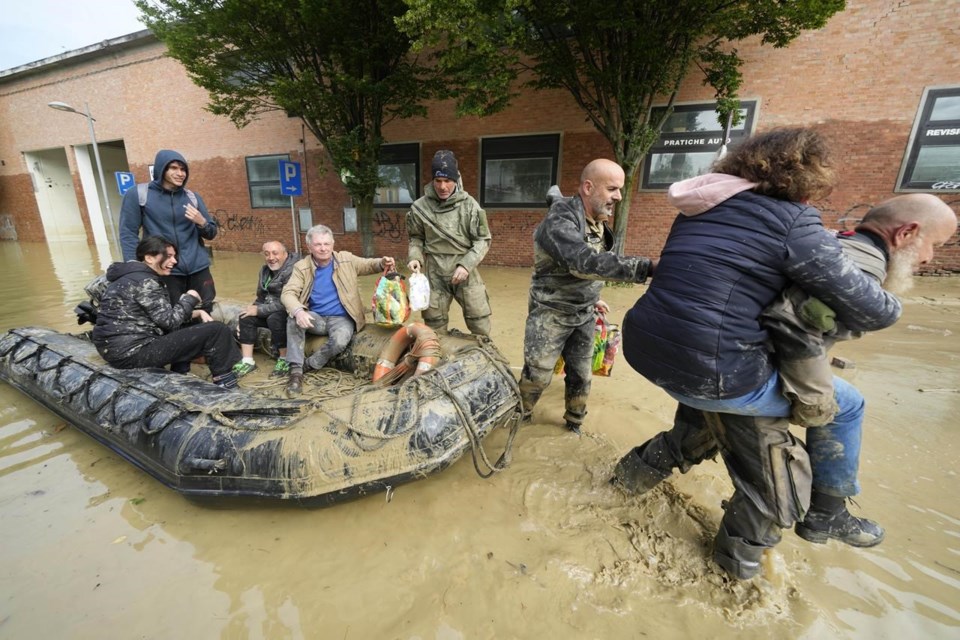ROME (AP) — A rare, triple-whammy of cyclones drove the deadly flooding that devastated much of northern Italy this month, but scientists said Wednesday that climate change doesn't seem to be to blame for the intense rainfall.
Using computer simulations and past observations, a team of researchers looked for but found no evidence of human-caused warming behind the drenching. World Weather Attribution compared what happened to a computer simulated world of no human-caused warming and didn't see the fingerprints of fossil-fuel-induced climate change, unlike in many past studies.
Still, precisely because having three exceptionally heavy downpours in such a short timeframe is so rare — the study estimated there was a 1-in-200 probability that three cyclones would strike within a three-week period — the climate experts cautioned that more time for study is needed.
“This is not the end of the story,'' said study co-author Davide Faranda, a researcher in climate physics at the Pierre-Simon Laplace Institute in France. "This event is too rare,'' he said during a panel to present the findings.
“Remember there was a drought before” the first storm pummeled the Emilia-Romagna region on May 2, and “this (drought) was due to climate change,” Faranda said. He was referring to two years of scant or no rainfall that left land so parched it couldn't absorb the first rainfall. Drought derived in large part to lack of Alpine snowfall, which usually replenishes the Po River and other, smaller waterways in Italy's north.
This study was undertaken “to answer the question of whether and to what extent climate change” was an influence in the flooding in Emilia-Romagna, said Friederike Otto, of Imperial College London, and a founder of the scientific group.
With hundreds of streets, homes, farms and other businesses still deep in floodwater, the study was done only a week ago and hasn't been peer-reviewed.
While the flood-prone region has a history of severe flooding, "the heavy rainfall over the first 21 days of May 2023 is the wettest event of this type in the record,'' the study concluded.
But “of the 19 models used, none of them show a significant likelihood or intensity of such an event to occur,'' the study said. "This suggests, that in contrast to most parts of the world, there is indeed no detectable increase in heavy rainfall in the Emilia-Romagna region in spring."
Looking at the May flooding, that phenomenon is "one where we clearly see no trend,'' said Otto.
The last of the three May floods was the most devastating and claimed 15 lives. The extremely heavy and concentrated rainfall triggered some 300 landslides and caused nearly two dozen rivers to overflow. The floodwaters were so high, firefighter and coastguard helicopters were needed to rescue some residents who climbed onto rooftops of three-story buildings to avoid drowning.
The study's findings corroborated earlier research that found that “with human-induced climate change, the number of low-pressure systems in the Mediterranean has decreased. This leads to a reduction in heavy rainfall, offsetting the expected increase in heavy rain from global warming.”
Emilia-Romagna is one of Italy's most productive regions for both agriculture and manufacturing. Like elsewhere in the north, during the nation's post-war economic boom, much of region was rapidly urbanized, depriving the area of terrain needed for drainage and increasing the risk of flooding.
All that "has exacerbated the impacts of the heavy rainfall. However, this was an extremely rare event, and most infrastructure cannot reasonably be built to withstand such low-frequency events,'' the scientists said in their findings.
"Disasters just don't happen from rain falling from the sky,'' said study co-author Roop Singh, of the Red Cross Red Crescent Climate Centre, based in the Netherlands.
___
Borenstein contributed from Washington.
___
Follow AP’s climate and environment coverage at https://apnews.com/hub/climate-and-environment
___
Follow Frances D'Emilio and Seth Borenstein on Twitter at @fdemilio and @borenbears
___
Associated Press climate and environmental coverage receives support from several private foundations. See more about AP’s climate initiative here. The AP is solely responsible for all content.
Frances D'emilio And Seth Borenstein, The Associated Press



